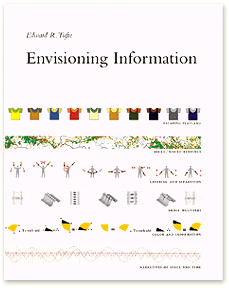 I got a copy of this book over the Christmas period (I now have all four of Tufte's books). This follows the pattern of the other three - beautiful production values, and an authoritative view (some might say didactic!) of design as applied to the graphical display of information. The book was originally published in 1990; the copy I have is the 10th printing from 2005.
I got a copy of this book over the Christmas period (I now have all four of Tufte's books). This follows the pattern of the other three - beautiful production values, and an authoritative view (some might say didactic!) of design as applied to the graphical display of information. The book was originally published in 1990; the copy I have is the 10th printing from 2005.
The book has six chapters: Escaping Flatland, Micro/Macro Readings, Layering and Separation, Small Multiples, Color and Information, Narratives of Space and Time, and finally a brief Epilogue.
The first chapter (Escaping Flatland) explores the representation of our three dimensional world in the two dimensions of the printed page. From minor examples (such as the moulted toad skin as a two dimensional representation of the three dimensional toad!), he proceeds to the major examples of Galileo's description of sunspot activity - this leads through to 20th century compilations of sunspot data in more abstract form. Other examples of displaying spatial information on the printed page include the diagrammatic notation of dance movements. Perhaps I am a bit dense, but where I found the sunspot diagrams easy to understand, dance notation was too complex. Via some lovely city maps drawn as three dimensional illustrations of cityscapes, this material seques neatly into the second chapter, which concerns to assembly of smaller details to a larger whole (Micro/macro readings). Standout examples include a discussion of the design of the Vietnam Veterans Memorial in Washington,DC.
See also:
The Visual Display of Quantitative Information
Envisioning Evidence is published by Graphics Press, Connecticut USA; ISBN 978-096139211-6
